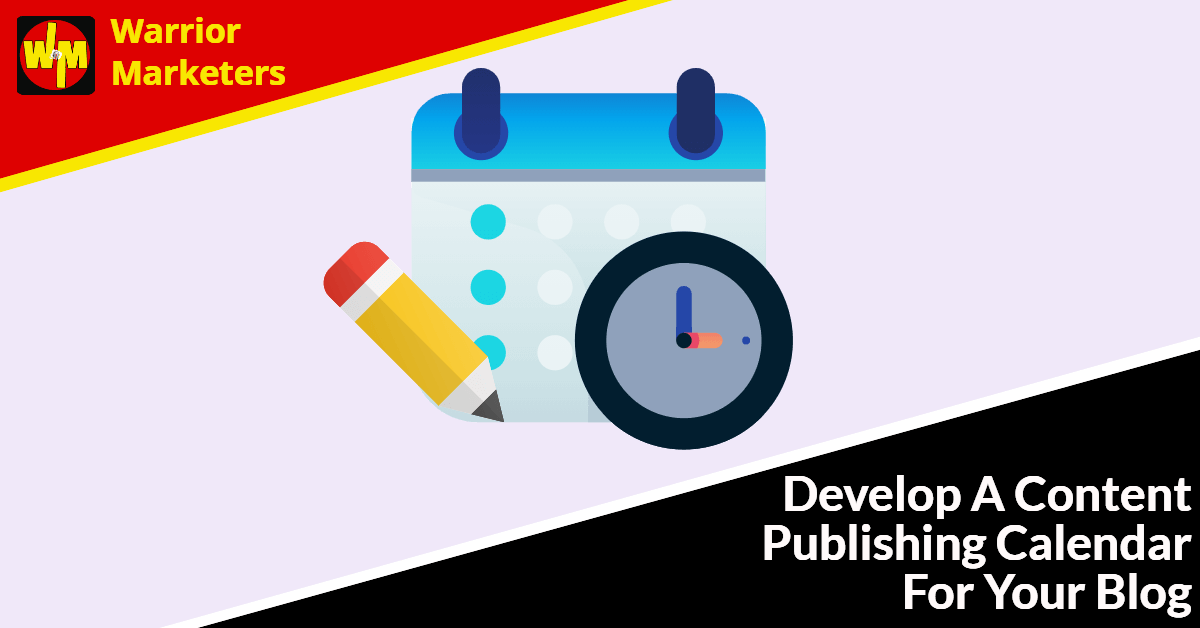content marketing
Develop A Content Publishing Calendar For Your Blog

Creating a content calendar that includes matching promos, helps ensure that you meet business goals, such as list building. When you plan your written content, match it to an existing or new opt-in freebie.
Write it all on your content calendar so you can remember what purpose each item serves.
OK, let’s look at how you can flesh out your content marketing calendar.
Set Your Goals

A few goals you might set are to expand brand awareness, promote thought leadership, increase word of mouth, get more leads, or make sales.
A funny meme can help you get more likes, shares, retweets, and spread brand awareness.
Product & Freebie Benefits

The best way to ensure that your content works with your products and freebies is to get familiar with them.
In other words, you must know “what’s in it for them” and what problem it solves.
Plan Publishing Frequency

Always publish to your website first and foremost. It will serve as the hub of your business and support content will lead visitors back to the site.
If you add “supporting content” on social sites, you can safely plan on adding something several times per day. Make sure each addition is “fresh”; otherwise, you will lose followers, instead of gaining opt-in subscribers.
Create, Curate, Or Contract

You’ll want to create some of the content yourself, but content can also be easily be curated or contracted out.
Another option is to collect related bits of information from multiple places to create something new.
Write it Down

Once you have created your plan, write it down.
You can use a spreadsheet or even a Google Calendar. The WordPress Editorial Calendar plugin can also help you pre-schedule and keep track of your website’s content.
All of this is content, so it makes sense to plan a week or more at the same time. Planning this way helps to ensure that you have every piece of content needed to meet your goals. In this case, the main goal focuses on growing your mailing list.
Post Content Regularly

Posting content on a regular basis is important. When you post unique content in a variety of places, it gives your audience more opportunities to see what you’re publishing and promoting.
Therefore, stick to your plan and ensure that you add new, relevant content on a regular basis.
Website/Blog

Content comes in many forms. Add a variety to keep readers’ interest and meet their needs. Inform and educate your audience with relevant audio, video, memes, infographics, charts, interviews, how-tos, statistics, and more.
What’s important is that you post something regularly, at least three times a week, to drive traffic to the content and the related opt-in offer.
Social Media

Each social media platform has a different “personality” so it’s important to post regularly. It’s also important to look at your analytics so you can identify when your audience is most active and reading.
However, check the rules and “best practices” at each platform to get recommendations specific to that site.

Don’t neglect to email your subscribers regularly about new content on the website or provide them with exclusive info related to that content.
Ask subscribers to “share” the website content with their friends, associates, and even customers/clients, when appropriate.
Enlist the help of your subscribers and reward them for that assistance with a special offer just for them.
Guest Posting

To get more traffic and opt-in subscribers from your guest posts, link to an opt-in that is relevant to the audience in your author profile or byline.
This gives you a huge incentive to guest post exceptional content frequently.
This is a win-win-win opportunity when you post on a regular basis.
Providing content for a variety of locations helps to increase targeted traffic and targeted traffic increases opt-in rates. The more you publish, the more people read your quality content and see your opt-in offer…unless your headlines aren’t persuading viewers to click to read more.
And remember, if you want to know the best way to get started with blogging you can check out Rapid Blogging Blueprint, a premium training on creating and monetising a blog the right way.
Or you can simply click on the featured resource below for a free Blogging Fundamentals report; download, read it and take action 😊

How To Make Your Blog More Appealing

Every blogger who earns income from their blog knows that the only way you can make money is by getting and keeping the traffic coming. Without your readers, you wouldn’t be making money at all.
With them goes their blog’s traffic that you could’ve benefited from if they’d linked to you. Here are some tips to make your blog appealing enough to keep the traffic there to earn you some money.
Design

The most common mistake some bloggers make is in their blog’s design. Blog readers not only look for interesting and informative content – they also want to come to an inviting space to read it.
The blog’s design needs to be inviting to them and comforting. It’s crucial not to have anything that would annoy them to the point of leaving because they can’t stand it. Make sure you’re not annoying them with colored font that’s hard to read or a bunch of graphics that are too distracting.
It’s fine to use colored font for your posts, but make sure it’s easy to read. A pale yellow font color against a pure white background may be too difficult for the visitors to read. They shouldn’t clash with the background color either. Clashing colors can give visitors headaches, so they’ll leave your site without bookmarking it for a later visit.
Content

The other common mistake bloggers tend to make is with their content. Some bloggers don’t update very often. If you only post once a month, your readers will forget you’re there and won’t return to your site.
Some bloggers also make the mistake of only providing text content to their blogs. Text posts are great, but mix it up a little every once in awhile with multi-media formats. Provide some interesting pictures, audio files and videos. Offer a little variety and your visitors will come back to check and see what else you’ve been up to.
It’s also important to stick to your blog’s niche topic. If you’re blogging about Homeschooling, then stick to that topic. Providing information about a celebrity’s latest excursion will turn off your readers unless it somehow relates to homeschooling.
Of course, having a good looking blog is only part of the puzzle. You have seen that you need great content to share with your readers but how do you go about finding and creating that content? Let’s take a closer look…
How To Find Great Content For Your Blog

In order to make your blog a successful money making entity, you’ll need to get traffic to it and keep them coming back.
Even the most successful bloggers start to run out of their own original content to post about. Some resort to scraping the bottom of the barrel to find things to discuss, but that ultimately loses them readers, which means less money streaming in.
Ideas

Where do you find great ideas to post about? There are actually many different things to use to get you out of your stuck-in-a-rut mode. These may be simple techniques to use, but they can be effective if used right. Here are some things to try the next time you get stuck for something to write about:
Scour the news sites – Search the news sites like CNN, MSNBC, and FOXNEWS and see if you can find a top story that you can blog about. Instead of just linking to the story, add your own accounting of it.
Check out your fellow blogger’s sites and see what they’re blogging about – It may seem unethical, but as long as you’re not stealing content, it’s perfectly acceptable to see what the community is interested in.
Is there a post that catches your eye? Is there something you can add to that post? A new spin you can put on it? Media outlets always have an eye on the competition to see what others are doing – and you should, too!
Research

Internet research – Do a search on the Internet for your blog’s topic. See what information you can come up with concerning your niche.
You may become inspired by something you’ve read there or you may think of some comments to post about it.
And what about podcasts or audio sites? You could try searching sites like Soundcloud to find audio to add to blog posts to enhance them for your readers.
Reviews

Consider doing reviews – Reviews can be a good filler to use while you try to get inspired again. Choose some articles, websites, books or whatever you can think of that’s related to your blog’s topic and post a review of it. If it’s a good review, add your affiliate link and make some money from your opinions!
If your blog is about flowers and you happened to go for a walk and saw some flowers on the way, use that as your post. Let your readers know what kinds of flowers are seen in your neighborhood and if possible, take come pictures to add since visual stimulation enhances the reader’s experience.
You can easily get back your inspiration for your blog posting if you look to other sources. They can help you come up with ideas of what you can share with your readers or they can give you a nice filler until your personal inspiration comes back. Don’t lose readers just because you’ve lost your blogging muse!
If you really want to know more about the power of blogging, you can take a look at the Rapid Blogging Blueprint training course or if you just want a few pointers for now you can grab the featured resource below for a free blogging report; download, read it and take action 🙂

Discover Why Content Will Make Or Break Your Affiliate Marketing

Affiliate marketing and content marketing are joined at the hip. If you want to be a good affiliate marketer, you need to put out good content. There’s no other way around that.
Even if you’re using paid advertising, you’ll be trying to get people on your email list. The emails that you send are content. There may be links to your blogs, reviews, etc.
The crux of the matter is that most people online come looking for either information or entertainment. Only a small percentage are ready to buy. This applies to anything from booking hotel rooms in a foreign country to buying a gun safe.
If you have a website that shows up when they search for the hotel reviews and you mention how the proximity of the hotel to the local watering holes is a plus point, or you show all the different activities they can engage in that’s just a stone’s throw away from the hotel – the visitor will read the content on your site eagerly because it pertains to them.
In most cases, they’ll click on your affiliate links and book the rooms. Now you’d have made an affiliate commission by providing content that the visitor was looking for. That’s how it works.
There are 5 pointers to note when creating content. Failure to adhere to the tips below will mean that your content marketing falls flat, and you’ll not see much affiliate sales.
Must Be Relevant

Your content must be relevant to the products you’re promoting. If you’re promoting an outdoor grill, you may wish to have content on what to look out for when purchasing grills.
Or how to clean grills… or even easy grilling techniques to prevent a mess. Whatever the content may be, it must be relevant.
What do they need help with? Write an article helping them and then link to the appropriate affiliate product you are promoting.
By targeting longtail keywords, you know that whoever comes to your content is a red-hot lead. Yes, the amount of traffic you will get will be less but it is highly targeted and much more likely to buy something you recommend if your content is informative and helpful.
Must Be Interesting

Your content must be interesting enough to hook the readers by the eyeballs and keep them reading to the last word. If your content is vapid and dull, the reader will yawn and click off the page. There goes your sale.
And, don’t be too formal and stuffy unless your niche expects that. Most niches don’t and readers will appreciate you trying to make the content interesting as well as useful.
Must Be Engaging

Facebook posts on your fan page are content too. So are the videos on your YouTube channel. But here’s what makes them so powerful – the engagement in the comments section.
Look at the comments and engage with your audience. The more you get to know them and respond to them, the more they’ll like and trust you. Engagement counts too.
Ask questions that encourage people to comment. Believe me, people are much more likely to comment if you simply ask them to.
You ultimately want to attract the people that “get” you and repel those that don’t.
This way you will be much more likely to see visitors to your blog content click through your links as they like what you have to say and trust you and your recommendations; just don’t let them down!
Must Be New

Your content needs to be new. You’ll have to keep publishing content to stay up-to-date.
There’s no point in having a hotel review on your website that’s 8 years old when the hotel has already been torn down to make way for a shopping mall.
Always have a content publishing strategy and stay relevant with the times.
You can either update existing content which means you won’t lose any of the SEO juice for that particular post, or you can write a completely new post; both options have pros and cons so choose which way you want to go and do it.
Must Be Reliable

Whatever content you publish must be reliable too. The term ‘fake news’ is being tossed about everywhere these days. You want content that is trustworthy.
Readers can sense hype and drivel. So, make your content useful and it will help to sell your affiliate products too.
If you are teaching strategies and/or tactics, make sure that you know what you are talking about. It is a good idea to always practice what you preach because at least you know what you are talking about works.
Stick to the 5 content creation and marketing tips above and you should see your content work better for you and increase clicks and ultimately, sales.
Many marketers are so focused on sales, traffic, and conversions that they neglect the content… which can make or break them. Don’t make this mistake.
“Content builds relationships. Relationships are built on trust. Trust drives revenue.” – Andrew Davis, Author
If you want to know more about affiliate marketing then check out the featured resource below for a free report; download it read it and take action 🙂

How To Get Traffic To Your Blog With Content Marketing

Blogging has truly revolutionized the way one experiences the digital age. There is apparently no limit to what you can do with the help of blogs. Even the smallest aspect of your daily personal life like recording journal entries has been given an entirely new dimension.
Going on from there, there is a lot of scope for picking up interesting debates and discussions through blogs. You can even start some of these discussions yourself.
And it is easier to do than you might think. Honestly, it isn’t rocket science; you don’t need to be a scientist who posts revolutionary details about his latest experiments.
If you blog well, i.e. if you are engaging enough that people want to come and read it, you have a really good chance of making some money, by just going about your daily activity of posting blogs on areas that interest your readers in your niche!
Here are some of the things you can do to make sure that your blogging activities get rewarded by more than just comments and praises:
You could get yourself registered with a search engine. Doing this will virtually guarantee that your blog will get a great deal of free, organic traffic, and traffic is the lifeblood of any blog/business.
In this way, the higher the ranking your blog achieves, the more you are likely to get paid because more people will be able to find your content quickly.

Here are a few tips to help you with your blog content:
- Reader Friendly Content: At all costs keep your content – articles, poems, photographs, videos – reader friendly, that is to say, it should keep more and more readers interested. Your reader must be at the center of you post in a way that your reader must feel that he is gaining something out of reading your post. This is the basic rule in marketing.
- Make It Worthwhile: Never let the reader feel that he has been tricked into reading your post or clicking on your blog link. You are thwarting all your long term chances of that reader coming back to your blog, in which case your blog rankings over the long term are in a dicey position.
- Check For Errors: Making grammatical and spelling errors can be a major put off for many readers. They may not visit your blog again simply because the errors that you make are too high. Always proof read your blog. A small typo here and there can be understood, but make sure you don’t make any major errors.
- KISS: Or, Keep It Short and Simple. This is the thumb rule you must follow at all point. Long winding posts tend to get boring. And it may contain nothing that is interesting to the reader. Also no one has the time enough for your blog, no matter how well you write. In fact, your blog will be much more appreciated if you put your thoughts simply and shortly.
- Make It Interesting: Make sure that you hold your reader’s attention by making your posts snazzy. They must not be written in a tone that is tiring to read. Write short sentences and keep then crisp and precise. Always hit the point immediately in the course of your article.
- Link: Keep linking the blogs you read to yours in order to build a network those people will be in turn encouraged to link you. Remember, linking increases rankings.
- Keywords: Using the keywords of your posts frequently increases the search ability of that particular article of yours which in turn leads more people to visit your blog.
- Clear Thoughts: Make sure you put your thought clearly before the readers so that it does not become tedious for them to read.
- Colloquialism: You can write in a friendly tone. Avoid using too many slang words, but otherwise, if your post demands it, you can be colloquial.
- Post Title: A catchy post title or headline is half your business solved. It can glue a reader to your post almost immediately. However, do not put misleading post titles, or you will lose creditability.
- Always Have A Call To Action: Writing an engaging blog post is great but remember that you want to make money from your content, so always have a call to action to click on a link that either goes to one of your own products or an affiliate offer where you will get a commission. You can see below that I have added several calls to action in this post, just like the one below where I am giving away a free checklist to keep you on track when setting up your blog, so click on the image below or click here if you want 🙂
So, be consistent with your blog content and watch the traffic start flowing in to your blog!
Do Blogs Still Work?
Do Blogs Still Work?

The question “Do blogs still work?” is one which gets asked a lot and the answer is quite simple.
Of course, they do!!
Put it this way; providing good high-quality information is exactly how to earn the favor of the search engines, which have the potential to make or break your business.
And since it dominates 75% of the global market share it’s best to focus all your efforts to rank on Google above all else.
So, how do blogs play into this?
Well did you know that 47% of buyers view 3 to 5 pieces of content before engaging with a sales representative, and companies with blogs tend to get 67% more leads than those who don’t have an updated and optimized blog.
And being found easily in the search engines is obviously going to play a key part in people finding your blog posts.
You could have the most amazing content on the internet but if people can’t find it you are wasting your time.
SEO, or Search Engine optimization, is a very important strategy when building your blog, especially off page SEO strategies, and these are continually evolving along with any updates to the Google algorithm.
Sometimes businesses just aren’t clear on how content production can lead to lead generation.
The simple answer is, as stated earlier, people will need several exposures to you and your content before they feel comfortable parting with their contact details or their cash.
Building up trust and authority status is crucial to your success, and a blog is an extremely powerful tool at your disposal, to build credibility and showcase your expertise.
So, are you still wondering “Do blogs still work?” Hopefully not, and here are some simple tips that you can use to optimize the way your blog will work for you.
These are easy to do, and you can get started right away; many are common sense, but you will be surprised that many blog owners are not doing them correctly, and that means you can get a competitive edge over them by following them.
OK, on with the tips…
Focus on quality rather than quantity

Going back a few years ago, short sub-500 word articles were the best type of article to write to gain a high ranking on Google, but those days are long gone.
Longer posts are much more favoured today and when I mean long, these articles can be over 3000 words, which is like a small ebook!
The focus is on high-quality information going deep into a topic that can really help your readers with their problems.
Don’t think you can just waffle and stuff keywords into your articles as you will be penalized.
Write with your reader in mind and you can’t really go wrong.
Having a content calendar/schedule is a great tactic to use to try to instill the habit of creating content regularly.
Some will say to write daily, some weekly, some monthly!!
The truth is, there is no right or wrong answer, but you must be consistent.
If you can only manage to write one article a month, that’s fine. Never sacrifice quality for quantity.
Once you have started writing your post you can move onto the next tip…
Encourage Engagement With Your Readers

When you are writing anything on your blog, try to write conversationally; use you and I in your writing i.e. talk to your reader one-to-one.
This really helps to create a connection with your readers. Don’t try to be aloof as the subject “expert” but rather try to position yourself as a fellow traveler.
This is much more engaging for both you and your readers.
Also, try to use stories if at all possible as these are incredibly engaging and powerful.
Another engaging post is a case study, and this also shows the readers proof that what you are writing about works.
If you allow comments on your posts, respond to all your comments as soon as is practicable for you. Having a dialogue is incredibly engaging for the reader involved but is also another indirect form of social proof.
So, now you have readers looking at your content. Let’s move on to the next tip…
Add A Call-To-Action

You should always write a blog post with the end goal in mind, whether it is for the reader to opt-in to your email list or to get them to click through to your offer.
Also use widgets to add opt-in forms or calls-to-action on your sidebar or use pop-ups and/or exit pops.
I can’t stress this enough; don’t just write a post for the sake of writing as it is a waste of time; after all, you are in business to make money and if you have people consuming your content, it is an ideal opportunity to get them to sign up or monetise them.
You may be uncomfortable using more intrusive forms such as the pop-up, but they do work, as long as any offer you are showing them is highly congruent to the post they are reading.
Working in tandem with the call-to-action is our next tip…
Use Content Upgrades

What is a content upgrade?
Well, basically it is another chance to further encourage your readers to sign up.
And, because the focus is on longer posts, a very quick and simple content upgrade to offer is a copy of the blog post in downloadable pdf format so they can read offline or at their convenience.
Other types of content upgrades that work well include checklists, video, audio etc.
Video/audio doesn’t necessarily mean just having a video or audio version of the blog post; it could also be some complementary training that enhances the information in the blog post.
Get creative and you can have many opportunities to capture your readers email address.
If you are going to offer a pdf of the post, then a really quick way to do this is to use either Post Gopher (a WordPress plugin) or, my personal favourite, Designrr. Both of these tools can produce a pdf version of the blog post, but Designrr allows you much more flexibility to customize the end result.
Using calls-to-action or content upgrades aren’t the only way to engage and entice your reader to sign up. Now you can have your very own personal assistant on your blog, leading on to our next tip…
Start Using Chatbots On Your Blog

Messenger chatbots are hot right now and have super high engagement and you can quickly use a service like ManyChat or MobileMonkey (you can use the free versions to begin with although the Pro versions aren’t that expensive).
When you have signed up you can use the service to install a small snippet of code on your website that will allow a custom chatbot to show on your blog; cool. eh?
Both Manychat and MobileMonkey work specifically with Facebook Messenger and have incredibly high engagement, and there aren’t that many blogs doing this at the moment, so it is definitely something worth looking into.
So, there are 5 ways to ensure that your blog is still relevant today and in the future.
Implement them and you will be able to answer anybody asking you “Do blogs still work?” with a resounding “Yes!”
As a bonus, here are 4 reasons why blogs don’t work.
When you look at blogs that are failing, there are normally some common reasons that keep popping up and these are summarized below.
Again, there is a lot of common sense here, but these things can be easily overlooked, so refer to this list often so you don’t fall into any of the traps that could be hampering your success.
A lack of basic SEO resulting in poor ranking

This blog post is NOT about SEO, but you really need to be doing the basics to give your blog an SEO boost.
On-page SEO, such as having a keyword rich post, having your main keyword in your post title, using internal links (if appropriate), optimising tags in any images used, using Yoast SEO plugin (if using WordPress) etc.
Off-page SEO is more important for ranking, and involves building backlinks to your blog, using broken link strategies, reaching out to influencers and guest blogging etc.
If these things aren’t in place, the chances are that your blog won’t rank, which means that few, if any, people will see it and no additional lead opportunity will be created, which, of course, will result in zero new sales.
Blog topics not researched or strategically created.

Serious question:
How can you know what topics are getting searched the most and are most relevant to your company if you’re not doing keyword research?
Writing blog posts with no target in mind is completely pointless.
You must do your research and find out what people are typing into Google to find the information that you are trying to give them.
Targeting these keywords will result in less competition, thus making it easier to rank for, BUT it must be a keyword that people are actually using!
Lack of understanding of the customer avatar and journey.

Some entrepreneurs don’t realise that people are reading their blog posts long before they ever converted. As stated earlier, it takes at least 3-5 exposures to your content before a reader will trust you; in all honesty it’s probably more like 7 exposures.
Along with keyword research, you should’ve already done your niche research and know who your ideal reader (and thus customer) is, and ALL your content should be written with this person in mind.
You also need to be able to analyse and track visitors to your website so you can see which post are working and which aren’t.
Without this kind proper analysis, it’s unlikely to know which blog posts actually led people to fill out a form or were part of leading people to fill out a form, so all the blogs were marked as a waste of time.
Lack of a coherent content promotion strategy

Even if you have done all of the above and you do have a wonderful blog that is based on keyword research and properly optimized you still need to promote the blog to your audience.
In all honesty, writing and publishing a blog post is only half the battle.
Without thinking about the different avenues to connect users to your content, your blog is only going to reach a fraction of your audience.
You should also share every blog post on your social media channels; share to Facebook, Instagram and Twitter at a bare minimum.
OK, there you have it. You now have 5 ways to ensure that your blog is staying relevant, and 4 things to keep an eye on to ensure that you aren’t sabotaging your success and not ranking as well as you could.
All there is to do now is to start cranking out that content…







